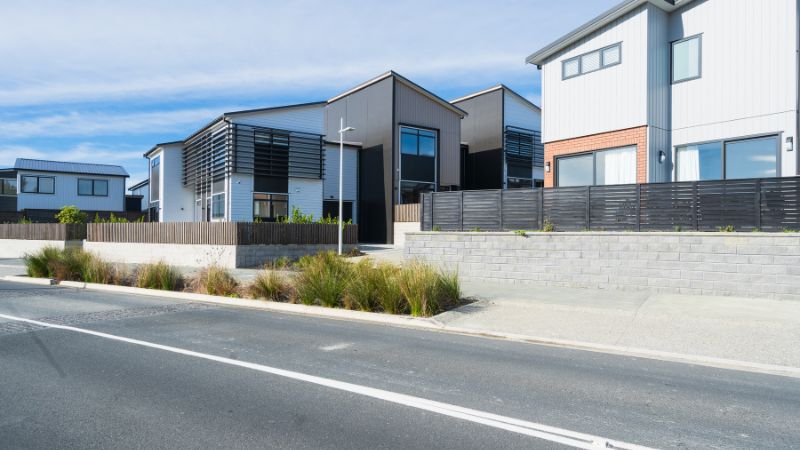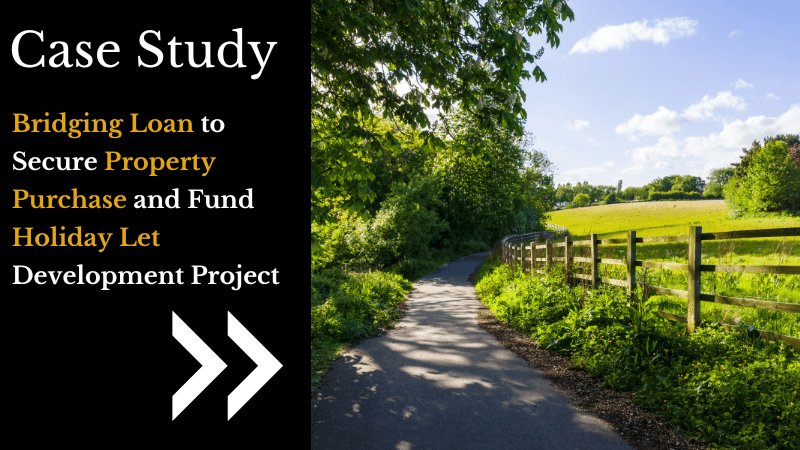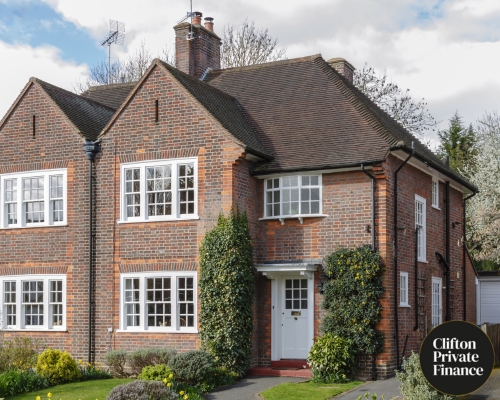Categories
Bridging Loans For Property Development | How It Works

Bridging loans for property development can get development projects underway fast – but both experienced and first-time developers don’t always fully understand the range of options available.
Property development bridging loans are typically only accessible from private or specialist lenders, who aren't particularly approachable for newbies in the industry.
With complex products to facilitate all sorts of development projects, it's very difficult to work out what lender is best suited for you, and with what type of loan.
This is where a bridging loan broker comes in - to help you understand the best finance for you, sift through the options on the market, and guide you through the application process.
Throughout this guide, we’ll showcase the uses of bridging loans for property development, how they work, how much they cost, how flexible they can be, and how much you can expect to borrow.
While you're here, check out our award-winning, property development bridging service.
Written by: Sam O'Neill & Sam Hodgson
Skip to:
What are property development bridging loans?
How does a property bridging loan work?
How are they useful for property developers?
What does a development bridging loan cost?
Property Development Bridging Loan Calculator
How much can I borrow with bridging finance?
What type of properties can a bridging loan be used for?
How can I get a bridging loan for property development?
What are property development bridging loans?
Bridging finance – or bridging loans – is a short-term property finance loan with various use cases - one of which is for property development.
While they're most commonly used for “bridging the gap” between buying a new property and selling an existing one – they're incredibly useful for funding renovation projects, flipping properties, to more complex development projects. The main difference between bridging and traditional borrowing is of course its speed and flexibility of use.
See similar: What is property development finance?
How does a property bridging loan work?
Property development bridging loans work like any other type of bridging loan or short-term financing. A bridging loan is secured against the value of property, or properties, being developed or invested in.
Here’s how it all typically works:
Application – Property developers apply for a bridging loan with a lender, typically with the help of an experienced broker who can compare lending options, providing all necessary details, such as; the scale and scope of the project, their individual finances, and information about the property(s) being developed.
Approval – A lender will review an application and determine approval through their own set of criteria, of which terms can differ from lender to lender and are also dependent on the situation. A lender will determine the terms, how long the loan will last, the interest rates, repayment, and any additional fees that may apply.
Funding – When a loan is approved, lenders provide the funds – with the aid of a good broker; this can happen very quickly (within two weeks, depending on complexity). The funds can then be used for the purposes of the borrower. In the case of property development, this might entail construction costs, renovations, or other improvements and related expenses associated with the project.
Development – With funds to hand, an investor or property developer can then complete their project, with an expectation that they will be able to later refinance or sell the property(s) that the bridging loan was secured against. Some bridging loans include a drawdown facility, so you can stagger your loan to suit your project, only paying interest on what you've drawn.
Repayment – When it comes to repaying the loan, the developer repays the bridging loan according to the terms set by the lender – this may include variances depending on the specific loan in question. Typically, a loan is repaid in full with the sale of the property(s) the bridge loan was secured against, alongside interest payments which can have multiple methods of repayment – including an option to roll-up interest to be paid in full at the end of the term.
For more details, watch our video: Bridging Loans Explained: Costs, Timescales, Examples, & How To Get One.

Sam O'Neill
Head of Bridging
Let us do all the hard work of finding the right bridging lender for your circumstances.
We secure bridging finance for applications of all types, and we negotiate competitive lending to meet your needs and timescale.
How are they useful for property developers?
Bridging loans can be organised very quickly – and when it comes to property development and the potentially large costs involved, this can be very useful to get a project off the ground.
Many property developers use bridging finance to take action quickly on investment opportunities that arise, allowing them to capitalise on a profitable development project.
Without the funds to hand, investors might miss out on lucrative opportunities – this is the main reason why this type of finance is used best by experienced developers, as it can be the only alternative when bespoke solutions, and fast financing, are needed.
With development loans, borrowers have access to larger-scale projects – their ambitions can be more easily met with short-term financing as traditional borrowing oftentimes proves far too slow.
What does a development bridging loan cost?
With property development finance, costs can sometimes exceed the initial expectation if they’re not clearly explained and laid out in advance (this is where a broker can help).
With a property development bridging loan, costs can vary depending on a few notable factors:
Loan Size – Property development loans are typically much larger than the average bridging loan due to project scale. Naturally, this affects the cost overall – the higher the loan amount, the bigger the interest payments (but your profit potential likely scales with this).
Interest rates – Interest rates for property development bridigng loans start at 5% per month, but more commonly range between 6.5-9%, depending on the risk and complexity of your project. There are typically multiple ways to repay interest, including; rolled-up interest payments, the standard monthly payments, or a retained interest method, to make this more flexible and fit in with your cash flow.
Additional fees – These include; valuation fees, arrangement fees, legal fees, broker fees - the costs of these fees will also vary depending on the lender and their terms.

With large-scale projects or property development of any kind – whether simple renovation of one property or investment opportunities for multiple properties - it is very important to consider your overall costs. It is not unusual that development projects run over on costs, and delays are often an inevitability that borrowers must be prepared for.
Even if you are an experienced investor or property developer, the help of an expert bridge loan broker can be invaluable when it comes to finding the right lender and the best possible property development loan.
Property Development Bridging Loan Calculator
For an initial idea of cost and repayment, you can use our bridging loan calculator to get a quote.
This will give you a figure for what you'll expect to pay, so you can work this into your project budget, including:
- Facility fee
- Monthly interest (rate and cost in sterling)
- Valuation fees
- Lender fees
- Broker fees
- Admin fees
How much can I borrow with bridging finance?
Bridging finance for property development can be secured from £100,000 up to £25M – with lower rates for loans over £1M.
How much you can borrow will depend on the property's value, the amount of equity you have in the property, your loan-to-value (LTV) ratio, and your ability to repay the loan.
Typically, property development loans can be secured with LTVs up to 80% - depending on asset value and could potentially be higher with additional assets.
Depending on the lender, the amount you can borrow will be affected by your own situation and creditworthiness – with a property development loan; you would likely need to provide additional detail to lenders, such as; a business plan, projections which demonstrate the viability of a development project (if on a large scale) and, of course, a reassurance on your ability to repay the loan through an exit strategy.
To get the best possible deal, it is recommended that you seek out a reputable lender – and an expert bridge loan broker can help here by determining your borrowing capacity and ensuring you're getting the best terms possible for your property development loan.
What type of properties can a bridging loan be used for?
Bridging finance can be used for a number of different properties, especially when it comes to property development. Here are some:
Residential properties – including single occupancy properties, Buy-to-lets, HMOs, and any apartment buildings.
Commercial properties – including office buildings, retail spaces, industrial properties, warehouses etc.
Mixed-use properties – These are properties that have a combination of residential and commercial units, such as a building with retail spaces on the ground floor and apartments on the upper floors.
Auction properties – bridging finance can be used to purchase properties at auction and properties that may be in an unmortgageable state.
Land –This can include undeveloped land or land that is slated for development, such as a property that has been zoned for residential or commercial use – an investor can make use of a property development loan to build on a site, or develop and renovate existing property.
Need a bridging loan for property development?
At Clifton Private Finance, we can facilitate a property development bridge loan via a number of specialist lenders across the entire short-term market – loans of this kind are typically only available from private and specialist development finance lenders. Without a broker, they can be difficult to approach directly. We can ensure you get to the right lender for your property project and get the best possible rates.
Whether you are a property developer or investor – we can get you a decision in principle quickly, for whatever your purposes are for a property development loan.
With our expertise and depth of knowledge, we can find you an appropriate lender with favourable rates.
Call us on 0117 959 5094 Or click here to make an online enquiry with us.
FAQs
Yes, a valuation is typically required for a bridging loan in the UK. Since bridging loans are often secured against a property or other valuable assets, lenders will want to assess the market value of the property being used as security. This helps the lender determine how much deposit they want you to provide based on the value and condition of the property. You can borrow up to £25m with bridging finance, but it’s typically capped at about 80% of the value of the property you’re using as security. It's important to note that different lenders have varying policies and criteria regarding the maximum loan amounts they offer for bridging finance. Some lenders have a maximum limit of over £1 million, while others may specialize in smaller loan amounts. Additionally, the terms and conditions of the loan, including interest rates and fees, should also be taken into consideration when determining the overall affordability of the bridging loan. Yes, you typically need a 20-40% deposit for a bridging loan. It can be possible to get a bridging loan without a deposit (a 100% bridging loan), but you’ll need other assets in the background to secure the loan against, and more stringent criteria and higher costs could apply. Yes, it is possible to get a 100% bridging loan (also known as a 100% LTV bridging loan), but it is rare. This means that you won’t need to put down a deposit and can borrow the full value of your property. However, the criteria for these loans can be hard to meet, and you’ll need to provide additional assets as security for your loan. Interest rates and fees can also be higher to compensate. While using bridging finance doesn’t technically make you a cash-buyer, it can allow you to act like one. Mortgages take months to process, often leading to an ‘onward chain’ where all parties involved need to wait for funds to be transferred. Bridging finance can usually be accessed a lot quicker than mortgages so you can bypass the onward chain, giving you an advantage over other buyers and being attractive to sellers. Bridging loans typically have a term of 12 months, but some lenders are willing to stretch their terms to 18 months, or even 2 –3 years depending on the case. Terms longer than 2 years will usually only be considered for specific cases. Yes, you can use a bridging loan to pay Stamp Duty. This amount could be covered by a bridging loan, providing you have a way to repay the additional borrowing amount to your lender. Yes, bridging loans are safe when they’re used in the right circumstances with a solid repayment strategy. However, we recommend speaking to a qualified advisor, like our brokers at Clifton Private Finance, before you take out a product. The main factors to consider with bridging finance are that the full loan amount will usually need to be repaid within a year, and like a mortgage, it is secured against a property as collateral. This means that in the case that you aren’t able to repay your bridging loan, your property would be at risk of repossession. But with a watertight exit strategy, bridging finance can be an efficient way to secure property quickly. Bridging loans are designed to be short-term so there’s no maximum age limit when applying for a bridging loan. This does depend on the lender, as some bridging lenders do have an upper age limit, but there are lenders on the market who offer bridging loans for borrowers aged 70 and over. Bridging loan interest rates usually range between 0.45% - 2% per month, depending on the case and the market rate. Unlike mortgage interest rates, bridging loan interest is calculated monthly instead of yearly. This is because bridging loans are short-term and, in many cases, repaid within a year. Bridging loans can be arranged without early repayment penalties, so interest is calculated monthly to ensure you only pay interest on the months you have the loan for. Unfortunately, mainstream banks in the UK don’t offer bridging loans. This means that if you’re looking for a bridging loan, you won’t be able to get one using a lender you’d find on the high street. There are a variety of specialist lenders that offer bridging loans, but because these lenders are smaller and more niche, you may need a bridging broker to access them. Banks typically charge two main fees when taking out a bridging loan – arrangement fees and interest. But there are other costs to consider such as valuation fees, broker fees and administration fees. Costs can vary from lender to lender, and will also depend on what your bridging loan is for (e.g., residential or commercial purposes.) Arrangement fees are what the lender charges you to take out the loan and can range between 1.5 - 3% of your overall loan. Bridging loan interest, on the other hand, is calculated monthly. This can catch borrowers out who may be expecting an Annual Percentage Rate (APR) like with a mortgage. Yes, you can convert a bridging loan to a mortgage through refinancing, and it is common among borrowers who use bridging finance to buy residential properties. However, whether or not you’ll be able to refinance to a mortgage is dependent on your financial circumstances, the lender, and the property you’re planning to buy. It’s important to be sure that refinancing is a viable repayment option before you take out a bridging loan on a residential property. Yes, bridging loans are typically more expensive than mortgages. Bridging loan interest rates can be much higher than a mortgage, and are calculated and displayed as monthly rates instead of the usual annual percentage rate (APR) that you’ll see on a mortgage. However, bridging loans are a short-term solution, and you’ll only pay interest on the months you’ve borrowed money for – and you can repay early without any charges (for most loans). There are many circumstances where bridging loans are an affordable option and a means to an end - for borrowers that need to finance a property purchase quickly, it may be the only option available. The two most common ways to pay a bridging loan are to sell a property or refinance to a mortgage. You may also need to ‘service’ the loan through the term, which means paying the interest monthly. However, you can opt to ‘roll up’ your bridging interest to be repaid at the end along with the capital. There are also other ways to repay a bridging loan, such as selling a business or even using money from an inheritance. The method in which you pay your bridging loan can be flexible, just as long as it is clear in your application that you have a surefire way to repay your loan when the terms are up. In most cases, a bridging loan will require a minimum deposit of 25%. However, the minimum can vary depending on the lender and the specific circumstances of the loan itself. Generally, bridging loans are secured against a property or other valuable assets, and the deposit required is often expressed as a percentage of the property's value, known as the loan-to-value ratio. In some cases, 0% deposit bridging loans are an option, but only if you have other property or assets in the background to provide additional security. No, typically, you’ll repay a bridging loan in one chunk at the end of the loan term. Bridging loans are a form of short-term finance and will usually need to be repaid within 12 months, but there can be room for flexibility. In some cases, borrowers may be required to make monthly interest payments. This means that each month, you would pay the interest accrued on the loan amount while the principal amount remains outstanding until the end of the loan term. But usually, the interest is "rolled up" or added to the loan balance and paid with the rest of the loan at the end of the term. This option can help protect your cashflow so you can spend it on moving costs or refurbishments, for example. Bridging loans can be arranged in as little as 7 working days. However, it depends on the complexity of the bridge loan and your specific circumstances. It may also be more expensive for you to rush an urgent application through – but not impossible. Bridging loans are a popular option for borrowers who are under time constraints, such as buying a property at auction or breaking a chain. The key factors lenders tend to consider are: Security - Bridging finance is usually secured against property or other valuable assets. Lenders will assess the value and marketability of your security. Exit Strategy - Lenders will want to understand how you plan to repay your bridging loan. In most cases, this is selling your old property, selling the new property (flipping), or refinancing with a long-term mortgage. Loan-to-Value (LTV) Ratio - Lenders consider the loan amount compared to the value of the property being used as security as a percentage. The LTV ratio can vary, but most lenders will have a maximum of 60-80% LTV. Remember, the criteria for obtaining bridging finance in the UK can vary depending on the lender and your circumstances.
Do you need a valuation for a bridging loan?
How much can you borrow with bridging finance?
Do you need a deposit for a bridging loan?
Can I get 100% bridging finance?
Does a bridging loan make you a cash buyer?
What is the longest bridging loan term?
Can I use a bridging loan to pay stamp duty?
Are bridging loans safe?
Can an 80 year old get a bridging loan?
What is the monthly interest rate on a bridging loan?
Do banks still do bridging loans?
How much do banks charge for bridging loans?
Can you turn a bridging loan into a mortgage?
Is a bridging loan more expensive than a mortgage?
How are bridging loans paid?
What is the minimum deposit for a bridging loan?
Do you pay monthly payments on a bridging loan?
How long does it take for a bridging loan to come through?
What is the criteria for bridging finance?












.png)

